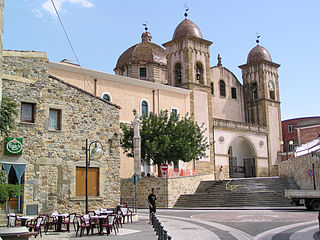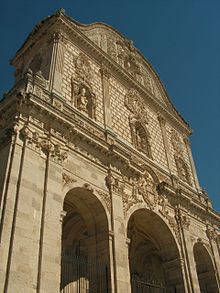History
The ecclesiastical history of Torres (Turris Lybissonis) goes back to the fourth century. In 304, the soldier Gavinus, Protus a priest, and the deacon Januarius suffered martyrdom there. Later Gavinus and Protus were reputed bishops, and said to have lived in the second and third centuries respectively. St. Gaudentius, who seems to have belonged to the beginning of the fourth century, is also venerated there.
The first bishop whose date is known is Felix (404). Other bishops include Marinianus, a contemporary of Gregory the Great; Novellus (685), whose ordination caused a controversy between Pope John V and the Archbishop of Cagliari; and Felix (727), who took refuge at Genoa from the Saracens.
Almost nothing is known concerning bishops of Torres for the next three centuries, till Simon (1065). His successor, Costantino de Crasta (1073), was an archbishop. Other archbishops: Blasius (1199), representative of Innocent III, on several occasions; Stefano, O.P. (1238), legate of Innocent IV in Sardinia and Corsica; Trogodario (about 1278) who erected the episcopal palace in Sassari, to which Teodosio (1292) added the Church of St. Andrea; after this the archbishops resided habitually at Sassari.
Pietro Spano (1422) was a restorer of discipline; under him the episcopal see was definitively transferred to Sassari by Pope Eugenius IV. This bishop intended to erect a seminary for the training of the clergy, but his death frustrated the plan. Angelo Leonini (1509) was at the Fifth Lateran Council; Salvatore Salepusi (1553) was distinguished at the Council of Trent; Alfonso de Sorca (1585), was highly esteemed by Clement VIII.
At about the year 1500, there were united to the Archdiocese of Sassari, the Diocese of Sorres (Sorrensis) which is mentioned as a bishopric in 1106, and whose last bishop was Jacopo Poggi; and the diocese of Ploaghe (Plubium), the first known bishop of which is Jacentius (1090).
Primate is a title or rank bestowed on some important archbishops in certain Christian churches. Depending on the particular tradition, it can denote either jurisdictional authority or (usually) ceremonial precedence.

Gavinus is a Christian saint who is greatly celebrated in Sardinia, Italy, as one of the Martyrs of Torres, along with his companions Protus, a bishop, and Januarius, a deacon.

The Judicates, in English also referred to as Sardinian Kingdoms, Sardinian Judgedoms or Judicatures, were independent states that took power in Sardinia in the Middle Ages, between the eleventh and fifteenth centuries. They were sovereign states with summa potestas, each with a ruler called judge, with the powers of a king.
The Diocese of Bosa was a Roman Catholic diocese in Sardinia that was founded in 1612 and merged into the diocese of Alghero-Bosa in 1986.
The Roman Catholic Diocese of Ampurias was a Latin suffragan Catholic bishopric in the north of Sardinia from 1070 till its suppression and merger with the Diocese of Civita-Tempio into the present Roman Catholic Diocese of Tempio-Ampurias.

Oschiri is a comune (municipality) and former bishopric in the Province of Sassari in the Italian region Sardinia, located about 170 kilometres (110 mi) north of Cagliari and about 40 kilometres (25 mi) southwest of Olbia.

The Archdiocese of Cagliari is a Latin archdiocese of the Catholic Church centred on the city of Cagliari. It holds the Primacy of Sardinia.
Juan Pilars was a Roman Catholic prelate who served as Archbishop of Cagliari (1514–1521) and Bishop of Sulcis (1503–1514).

The Archdiocese of Tarentaise was a Roman Catholic diocese and archdiocese in France, with its see in Moûtiers, in the Tarentaise Valley in Savoie. It was established as a diocese in the 5th century, elevated to archdiocese in 794, and disbanded in 1801. The diocese of Tarentaise was again formed in 1825, and united with the diocese of Chambéry and diocese of Saint-Jean-de-Maurienne to form the Archdiocese of Chambéry, Maurienne and Tarentaise in 1966.

The Diocese of Tivoli is a Latin Church ecclesiastical territory or diocese of the Catholic Church in Latium, Italy, which has existed since the 2nd century. In 2002 territory was added to it from the Territorial Abbey of Subiaco. The diocese is immediately exempt to the Holy See.

The Diocese of Nuoro is a Latin Church diocese of the Catholic Church in Sardinia. It is a suffragan of the archdiocese of Cagliari. Historically it was the diocese of Galtellì until 1779, and then the diocese of Galtellì-Nuoro until 1928.

The Diocese of Tempio-Ampurias is a Latin Church diocese of the Catholic Church in Sardinia, Italy. Until 1986 it was known as Diocese of Ampurias e Tempio. It is a suffragan of the Archdiocese of Sassari

The Diocese of Altamura-Gravina-Acquaviva delle Fonti is a Latin Church diocese of the Catholic Church in Apulia, southern Italy, 40 km south-west of the coastal city of Bari. In 1986. the territorial prelature of Altamura e Acquaviva delle Fonti was united with the diocese of Gravina. The present diocese is a suffragan of the archdiocese of Bari-Bitonto.

The Diocese of Acqui is a Latin diocese of the Catholic Church that straddles the (civil) regions of Piedmont and Liguria, in northwest Italy. The ancient Roman name of the place was Aquae Statiellae, which was sometimes confused with Aquae Sentiae (Aix-en-Provence), and Aquae Augustae (Dax), where there were also bishops. Acqui had always been subordinate to the Province of Milan, down until 1817, when Pope Pius VII assigned it to the Province of Turin. As a suffragan of the Archdiocese of Turin, it falls within the ecclesiastical region of Piedmont.

The Diocese of Ales-Terralba is a Latin diocese of the Catholic Church located in Sardinia, Italy. It is a suffragan of the Archdiocese of Oristano.

The Diocese of Iglesias is a Latin Church diocese of the Catholic Church in Sardinia. It is a suffragan of the archdiocese of Cagliari.

The Diocese of Lanusei is a Latin Church diocese of the Catholic Church in Sardinia; before 1986 it was the diocese of Ogliastra. It is a suffragan of the archdiocese of Cagliari.

The Diocese of Alghero-Bosa is a Latin Church diocese of the Catholic Church. It is a suffragan of the Metropolitan Archdiocese of Sassari, on Sardinia, insular Italy.

The Diocese of Ozieri s a Latin Church diocese of the Catholic Church in Sardinia, Italy. It is a suffragan of the Metropolitan Archdiocese of Sassari.
The Roman Catholic Diocese of Civita(-Tempio) was a Latin Catholic bishopric in the Gallura region of northern Sardinia.
This page is based on this
Wikipedia article Text is available under the
CC BY-SA 4.0 license; additional terms may apply.
Images, videos and audio are available under their respective licenses.















